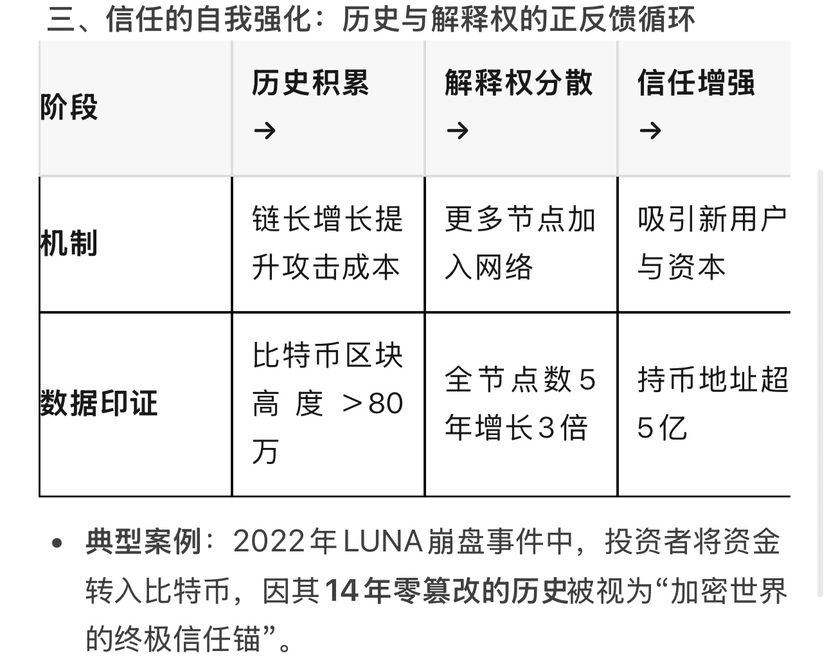I. History: 'Immutable facts' anchored in the physical world
1. Objective historical record of the hash chain
Timestamp blockchain: Bitcoin packages each transaction in chronological order into blocks, with each block containing the hash of the previous block, forming a cryptographic chain. Modifying any historical block requires recalculating the hashes of all subsequent blocks (which requires a 51% attack), with costs growing exponentially with the chain length.
The objectivity forged by energy: Each block's generation consumes real-world energy (PoW mechanism), making historical tampering incur quantifiable costs in the physical world (e.g., attacking Bitcoin requires consuming 1% of annual electricity usage). Historical records thus detach from subjective narratives and become an objective existence at the level of physics.
Case: The 2010 'pizza transaction' (10,000 BTC for 2 pizzas) can still be publicly verified today, as this history cannot be erased or rewritten due to being synchronized and recorded by thousands of nodes.
2. Transparent tracing of the UTXO model
Bitcoin uses an unspent transaction output (UTXO) model, where the flow path of each coin can be traced back to the genesis block and current holder's address. This transparency makes all transaction history a public 'trust evidence repository'.
II. Interpretation rights: 'No monopoly' of decentralized games
1. Democratic explanation of node verification
In the Bitcoin network, all nodes (over 50,000 globally) independently verify the validity of transactions and blocks. Each node has equal rights to interpret history:
Rejecting invalid history: If a miner attempts to tamper with a transaction, nodes will reject their block, making it invalid.
Consensus chooses the longest chain: Nodes automatically select the chain with the most accumulated work as the 'real history', without the need for central authority adjudication.
This design ensures that historical interpretation rights are decentralized among global nodes, preventing anyone from monopolizing the narrative.
2. Balance of miners and users
Miners: Responsible for producing blocks, but if they construct invalid transactions or tamper with history, the blocks will be rejected by nodes, causing the miner to lose mining rewards.
Users: Verify transactions by running nodes or light wallets and use 'code voting' to decide which segment of history to accept.
Market punishment mechanism: If miners engage in malicious behavior leading to a collapse of trust, a drop in coin price will render their hardware investments sunk (e.g., after the BCH hash war failure in 2018, miners withdrew).
Key point: Bitcoin transforms historical interpretation rights into programmed rules + economic games, with the ownership of interpretation rights dynamically balanced by the entire network's computing power, nodes, and holders, avoiding narrative control by a single entity.
III. Self-reinforcement of trust: The positive feedback loop of history and interpretation rights

IV. Comparing PoS: The centralization risk of historical interpretation rights
The trust defect of PoS chains like Ethereum stems from their deviation from Bitcoin's 'history-interpretation rights' model:
Risks of historical tampering
PoS lacks physical cost barriers, allowing attackers tolaunch long-range attacksto cheaply reconstruct historical chains (by purchasing old private keys). Although solutions like checkpoints exist, they rely on developers' subjective settings, violating decentralization principles.Interpretation rights concentrate towards capital
Staking monopolizes the narrative: Verification rights are determined by the amount held (32 ETH threshold), allowing the wealthy to expand their influence through staking rewards.
Institutional control nodes: Exchanges like Coinbase and Kraken control over 30% of Ethereum's staking volume, effectively holding the historical interpretation rights.
Result: The historical interpretation rights of the PoS chain have devolved from 'democratic validation by all network nodes' to 'aristocratic voting of stakers', reproducing the centralized narrative manipulation of traditional finance.
Conclusion: How does Bitcoin lock in trust with a 'code constitution'?
History is physical reality
Transforming transaction records into consumable needsreal energyof the hash chain, making the cost of historical tampering exceed the benefits, establishing an objective foundation of trust.Interpretation rights are procedural justice
throughproof of work + node verificationgame design, allowing historical interpretation rights to be decentralized among global participants, preventing any individual (including creator Satoshi Nakamoto) from monopolizing the narrative.Trust means trustless
Users do not need to trust any institution or individual—just the mathematical rules and physical laws. This mechanism makes Bitcoin the first trust system of humanitythat does not rely on the authority of interpreters, perfectly illustrating the ultimate balance of 'history and interpretation rights'.#BTC